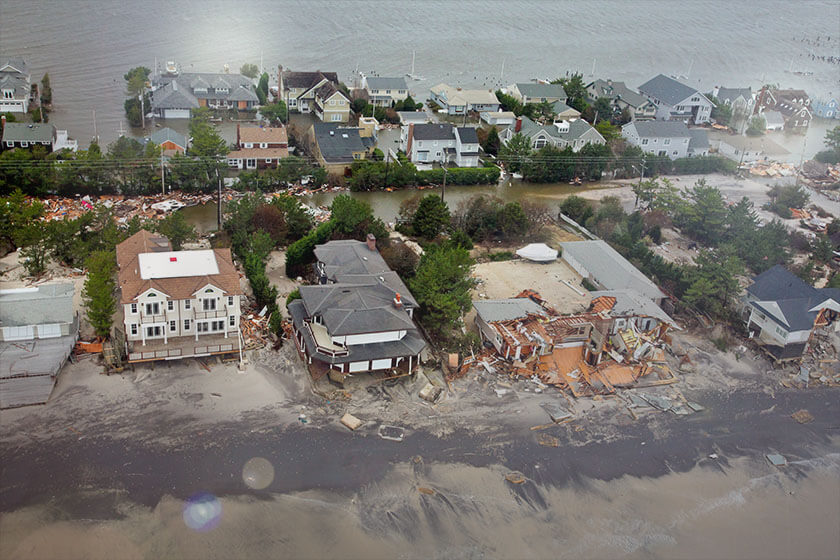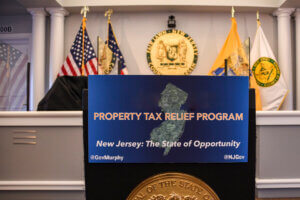Contact: TIMOTHY TRACEY, 732-263-5672 (office), 732-927-3636 (cell) ttracey@monmouth.edu
As New Jersey marks the 4 th anniversary of Superstorm Sandy’s landfall, the latest Monmouth University Poll of state residents who were hit the hardest finds that significant progress has been made in the state’s signature recovery program. However, most of these residents remain dissatisfied with the state’s recovery efforts, although positive views have increased slightly. These are the results from the latest installment of the Sandy Recovery Panel Survey, which has tracked the experiences of some of New Jersey’s hardest-hit residents over the past four years.
Four years after Sandy, less than half (46%) of hard-hit residents who have been participating in the multi-year panel are satisfied with the state’s recovery effort, while most (54%) are dissatisfied. The percentage of participants who are satisfied with the recovery effort four years removed from Sandy marks a slight improvement from last year (40%), and a more noticeable improvement from the 2014 (33%) and 2013 (34%) surveys. Additionally, 48% of survey participants believe the state’s recovery effort is focused on helping people like them. This represents an improvement from 2015 (38%) and 2014 (30%), and is now twice as high as in 2013 (24%) when Monmouth initially interviewed these residents about one year after the storm hit. Still, more than half (52%) say people like them have been largely forgotten.
“Satisfaction levels with the state’s recovery remain underwater, although we are beginning to see them creep closer to positive territory as more and more residents finish their rebuild. Not surprisingly, reaching the finish line in rebuilding one’s home clearly has a significant impact on satisfaction,” said Timothy Tracey, project manager for Monmouth’s Sandy Recovery Survey, which has tracked the experiences of over one thousand hard-hit residents since the first anniversary of Sandy. The results in this report represent the views of more than 300 respondents who participated in the most recent update.
Currently, 71% of all Sandy Recovery Survey participants report they are living in their pre-Sandy homes, which is up slightly from 2015 (66%) and 2014 (62%), and even more from 2013 (57%). Another 15% say they are permanently displaced, which has grown slightly over the past four years, from 12% in 2015, 9% in 2014, and 8% in 2013. About 1-in-7 (15%) say they are waiting to move back, compared with 23% in 2015, 28% in 2014, and 38% in 2013.
For the second year in a row, significant progress has been made in the Rehabilitation, Reconstruction, Elevation, and Mitigation (RREM) program. Currently, 59% of participants who were initially approved for RREM say they have finished rebuilding their homes through the program. This is up considerably from 32% in 2015 and just 5% in 2014. Just 8% of RREM participants are still waiting for construction to begin, which is down from 2015 (34%) and even more significantly from 2014 (87%).
The survey also found that 13% of those who were initially approved for RREM say they are no longer in the program, similar to the 2015 attrition rate (11%). Among those who are no longer in the program, 56% say they voluntarily withdrew or gave up, 28% say they were eventually determined to be ineligible by the state, 11% accepted assistance from another government assistance program, 6% were withdrawn by the state, and 6% say they were determined ineligible for the program after they received an additional payout from their flood insurance claim.
“After a notoriously rough start to the RREM program, it seems the wheels have become unstuck. Still, more than three years after the program began, a significant number of residents in the program have yet to make it all the way through,” said Tracey.
About 6-in-10 (59%) participants in the RREM program are satisfied with the recovery effort, up from 2015 (46%), 2014 (35%), and 2013 (32%). However, the amount of progress made in the program correlates with satisfaction, with 71% of those who report they have finished rebuilding being satisfied, compared with 55% in 2015, 42% in 2014, and 33% in 2013. By contrast, just 33% of those who have yet to make it to the finish line are satisfied, compared with 31% in 2015, 21% in 2014, and 33% in 2013. The following statements from two survey participants capture these conflicting sentiments:
” The RREM portion of our home was completed by the end of 2015, and we have had all final inspections by RREM…It was a long and difficult road to rebuild our home, but I love it and am so grateful to RREM and so happy to be back in our home after living 3 years with family.” – Toms River, NJ homeowner.
” My biggest mistake EVER was to accept the RREM grant. The program has left me and my family displaced for over a year – homeless and yet carrying a mortgage after being scammed by a con artist who the state themselves approved .” – Sayreville, NJ homeowner.
Among those who were initially approved for RREM but are no longer in the program, just 25% are satisfied, similar to this group’s satisfaction levels over the past three years. Four-in-ten (41%) of those who did not apply for RREM are satisfied, up slightly from 2015 (35%) and 2014 (37%), but slightly lower than in 2013 (45%).
Four years removed from Sandy, two-thirds (67%) of all survey participants, including 71% who received RREM assistance and 64% who did not, report having finished rebuilding or repairing their homes. This is up from 53% in 2015 and 30% in 2014. Another 18% have started but not finished, 4% have not yet started, and 10% say they are not rebuilding.
Turning to the state’s reNew Jersey Stronger program, which was set up by the state in the aftermath of Sandy to administer several state recovery programs, including the homebuyer assistance and resettlement programs, as well as RREM. Over half (53%) of panel participants who registered for assistance through reNew Jersey Stronger, regardless if they were approved for assistance through any program, say they are satisfied with the responsiveness of the program, which is down slightly from 2015 (58%), but still higher than in 2014 (43%). Half (51%) say the program did a good job keeping them informed, which is up slightly from 2015 (47%) and up more significantly from 2014 (36%). An identical 51% say it has been easy to contact someone from the program to get answers or information, similar to 2015 (49%) but higher than in 2014 (41%).
In terms of the helpfulness of different groups, family and friends (86%) continue to be seen as the most helpful during Sandy recovery, followed by neighbors (69%), community organizations such as the Red Cross and churches (53%), the state government (52%), local municipal government (50%), the federal government (50%), insurance companies (47%), and county government (25%). Each of these ratings have held steady over the past year with the exception of the federal government (up from 43% in 2015). Not surprisingly, those who report being approved for RREM assistance (76%) are significantly more likely to say the state government has been helpful than those who were initially approved but are no longer in the program (28%), respondents who were denied RREM assistance (39%), and those who did not apply (29%).
About Monmouth University’s NJ Sandy Recovery Panel:
This release marks the tenth installment of findings from Monmouth University’s tracking panel of New Jersey residents who were hardest hit by Superstorm Sandy. Results from the first wave of the panel were released in October 2013, February 2014, and March 2014. Results from subsequent waves were released in October 2014 and October 2015. Monmouth has also released five polls tracking statewide opinion of the recovery’s progress over the past four years as well as a separate survey of New Jersey coastal residents’ post-storm views of rebuilding policies. This represents an unpatrolled level of research on post-Sandy public attitudes and behaviors. Monmouth’s previous reports can be found at https://www.monmouth.edu/polling-institute .
Methodological Note:
The Monmouth University Polling Institute conducted the Sandy Recovery Survey online and by telephone with New Jersey residents who were displaced from their homes for a month or more or sustained $8,000 or more in damage to a primary home due to Superstorm Sandy. The results presented in this report were based on interviews completed between August and October 2016. This survey is part of a panel study designed to track the experiences of New Jersey residents who continue to be impacted by the storm. The initial survey was conducted between September 2013 and January 2014, the first follow up survey was conducted between July and October 2014, and the second follow up survey was conducted between August and September 2015.
The results presented in this report comparing changes throughout the four survey years are for 317 New Jersey residents who participated in all four waves of the panel. The results reported for demographic sub-groups are among all 517 respondents who participated in this year’s survey. Because survey respondents were recruited using a variety of non-probability methods, the survey results cannot be statistically projected to the larger population of all Sandy victims in the state. The value of these survey findings rests in comparisons over time among the same group of residents to better understand individual-level recovery progress as well as for internal poll comparisons among different groups (e.g. variations between those who remain displaced and those who are now back in their homes, variations by income levels, etc.).
This project was designed to complement Monmouth University’s statewide and regional poll tracking of Sandy issues and specifically to highlight continuing issues in New Jersey’s Sandy recovery and provide recommendations for improving communication channels between hardest-hit residents and public/private authorities. This project was made possible by a New Jersey Recovery Fund grant from the Community Foundation of New Jersey and the Geraldine R. Dodge Foundation.
Click on pdf file link below for full results and trends.




